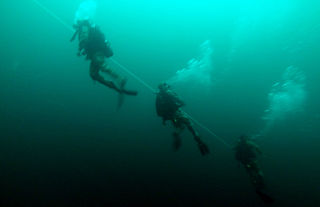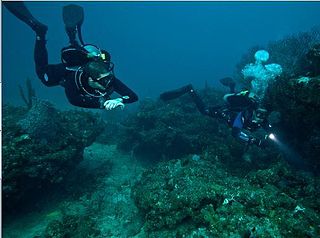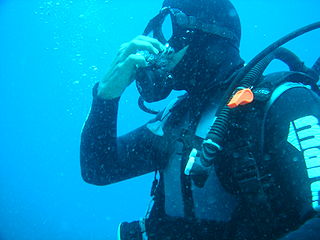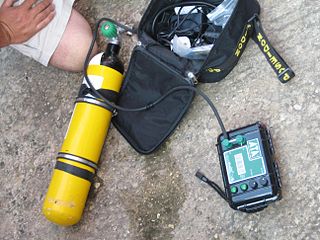 W
WAn emergency ascent is an ascent to the surface by a diver in an emergency. More specifically it refers to any of several procedures for reaching the surface in the event of an out-of-air emergency, generally while scuba diving.
 W
WAn emergency ascent is an ascent to the surface by a diver in an emergency. More specifically it refers to any of several procedures for reaching the surface in the event of an out-of-air emergency, generally while scuba diving.
 W
WDiver communications are the methods used by divers to communicate with each other or with surface members of the dive team. In professional diving, communication is usually between a single working diver and the diving supervisor at the surface control point. This is considered important both for managing the diving work, and as a safety measure for monitoring the condition of the diver. The traditional method of communication was by line signals, but this has been superseded by voice communication, and line signals are now used in emergencies when voice communications have failed. Surface supplied divers often carry a closed circuit video camera on the helmet which allows the surface team to see what the diver is doing and to be involved in inspection tasks. This can also be used to transmit hand signals to the surface if voice communications fails. Underwater slates may be used to write text messages which can be shown to other divers, and there are some dive computers which allow a limited number of pre-programmed text messages to be sent through-water to other divers or surface personnel with compatible equipment.
 W
WDiver rescue, following an accident, is the process of avoiding or limiting further exposure to diving hazards and bringing a diver to a place of safety. A safe place is often a place where the diver cannot drown, such as a boat or dry land, where first aid can be administered and from which professional medical treatment can be sought. In the context of surface supplied diving, the place of safety for a diver with a decompression obligation is often the diving bell.
 W
WDiver training is the set of processes through which a person learns the necessary and desirable skills to safely dive underwater within the scope of the diver training standard relevant to the specific training programme. Most diver training follows procedures and schedules laid down in the associated training standard, in a formal training programme, and includes relevant foundational knowledge of the underlying theory, including some basic physics, physiology and environmental information, practical skills training in the selection and safe use of the associated equipment in the specified underwater environment, and assessment of the required skills and knowledge deemed necessary by the certification agency to allow the newly certified diver to dive within the specified range of conditions at an acceptable level of risk. Recognition of prior learning is allowed in some training standards.
 W
WRecreational diver training is the process of developing knowledge and understanding of the basic principles, and the skills and procedures for the use of scuba equipment so that the diver is able to dive for recreational purposes with acceptable risk using the type of equipment and in similar conditions to those experienced during training.
 W
WThe diving supervisor is the professional diving team member who is directly responsible for the diving operation's safety and the management of any incidents or accidents that may occur during the operation; the supervisor is required to be available at the control point of the diving operation for the diving operation's duration, and to manage the planned dive and any contingencies that may occur. Details of competence, requirements, qualifications, registration and formal appointment differ depending on jurisdiction and relevant codes of practice. Diving supervisors are used in commercial diving, military diving, public safety diving and scientific diving operations.
 W
WA diving team is a group of people who work together to conduct a diving operation. A characteristic of professional diving is the specification for minimum personnel for the diving support team. This typically specifies the minimum number of support team members and their appointed responsibilities in the team based on the circumstances and mode of diving, and the minimum qualifications for specified members of the diving support team. The minimum team requirements may be specified by regulation or code of practice. Some specific appointments within a professional dive team have defined competences and registration may be required.
 W
WDoing It Right (DIR) is a holistic approach to scuba diving that encompasses several essential elements, including fundamental diving skills, teamwork, physical fitness, and streamlined and minimalistic equipment configurations. DIR proponents maintain that through these elements, safety is improved by standardizing equipment configuration and dive-team procedures for preventing and dealing with emergencies.
 W
WEar clearing or clearing the ears or equalization is any of various maneuvers to equalize the pressure in the middle ear with the outside pressure, by letting air enter along the Eustachian tubes, as this does not always happen automatically when the pressure in the middle ear is lower than the outside pressure. This need can arise in scuba diving, freediving/spearfishing, skydiving, fast descent in an aircraft, fast descent in a mine cage, and being put into pressure in a caisson or similar pressure-bearing structure, or sometimes even simply travelling at fast speeds in an automobile.
 W
WAn emergency ascent is an ascent to the surface by a diver in an emergency. More specifically it refers to any of several procedures for reaching the surface in the event of an out-of-air emergency, generally while scuba diving.
 W
WFitness to dive,, is the medical and physical suitability of a diver to function safely in the underwater environment using underwater diving equipment and procedures. Depending on the circumstances it may be established by a signed statement by the diver that he or she does not suffer from any of the listed disqualifying conditions and is able to manage the ordinary physical requirements of diving, to a detailed medical examination by a physician registered as a medical examiner of divers following a procedural checklist, and a legal document of fitness to dive issued by the medical examiner.
 W
WA Helium analyzer is an instrument used to identify the presence and concentration of helium in a mixture of gases. In Technical diving where breathing gas mixtures known as Trimix comprising oxygen, helium and nitrogen are used, it is necessary to know the fraction of helium in the mixture to reliably calculate decompression schedules for dives using that mixture.
 W
WInternational Marine Contractors Association (IMCA) is a leading international trade association for the marine contracting industry. It is a not for profit organisation with members representing the majority of worldwide marine contractors in the oil and gas and renewable energy industries. IMCA was formed by the merger of the Association of Offshore Diving Contractors (AODC) with the Dynamically Positioned Vessel Owners Association (DPVOA) in 1995.
 W
WNarcosis while diving is a reversible alteration in consciousness that occurs while diving at depth. It is caused by the anesthetic effect of certain gases at high pressure. The Greek word νάρκωσις (narkōsis), "the act of making numb", is derived from νάρκη (narkē), "numbness, torpor", a term used by Homer and Hippocrates. Narcosis produces a state similar to drunkenness, or nitrous oxide inhalation. It can occur during shallow dives, but does not usually become noticeable at depths less than 30 meters (100 ft).
 W
WSurface-supplied diving is diving using equipment supplied with breathing gas using a diver's umbilical from the surface, either from the shore or from a diving support vessel, sometimes indirectly via a diving bell. This is different from scuba diving, where the diver's breathing equipment is completely self-contained and there is no link to the surface. The primary advantages of conventional surface supplied diving are lower risk of drowning and considerably larger breathing gas supply than scuba, allowing longer working periods and safer decompression. Disadvantages are the absolute limitation on diver mobility imposed by the length of the umbilical, encumbrance by the umbilical, and high logistical and equipment costs compared with scuba. The disadvantages restrict use of this mode of diving to applications where the diver operates within a small area, which is common in commercial diving work.